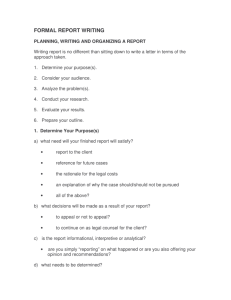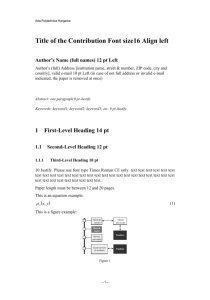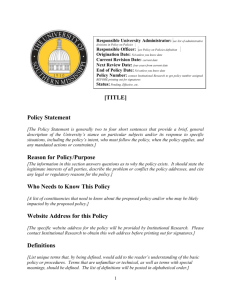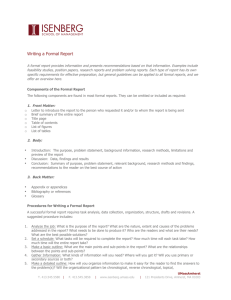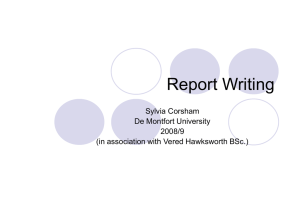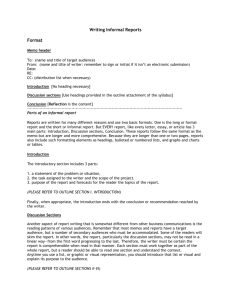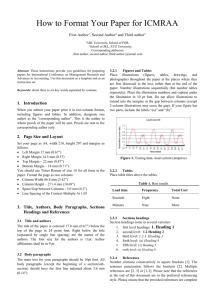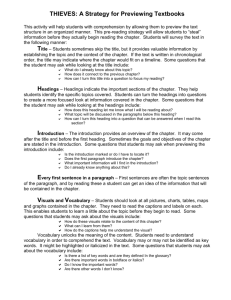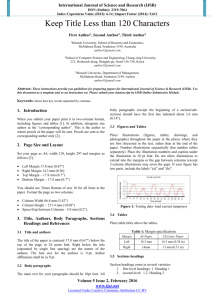Requirements for Writing Work Term Reports
advertisement
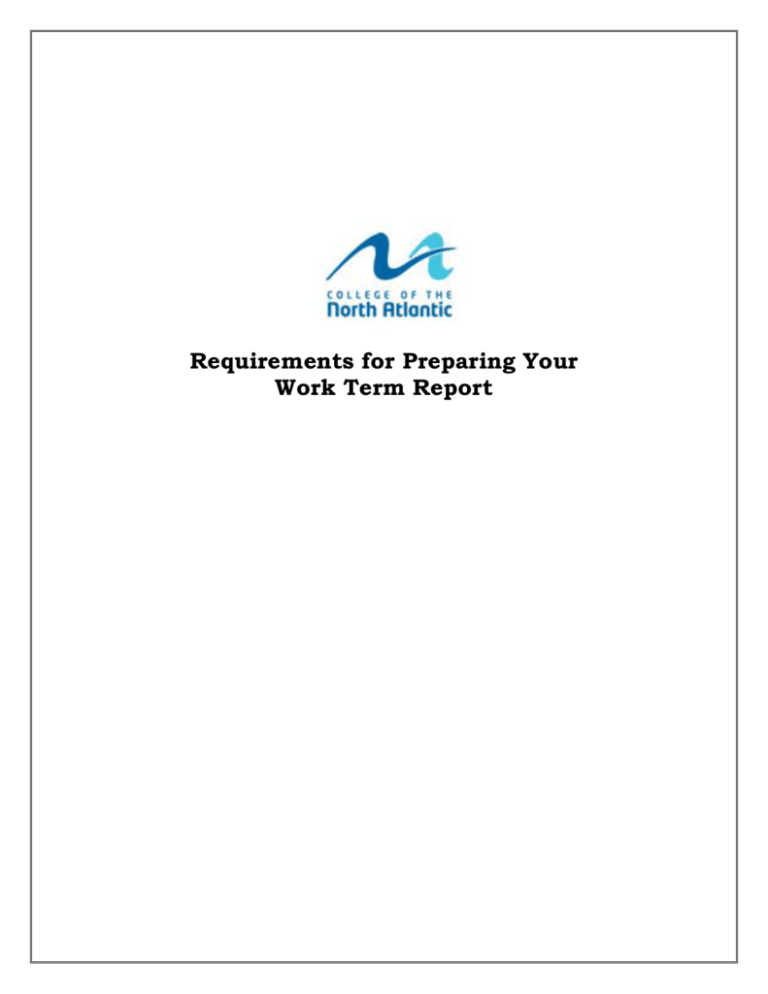
Requirements for Preparing Your Work Term Report Work term reports are expected to be technical and analytical in nature and usually address substantial subjects such as: the feasibility of a design or project an evaluation of the application of a new process or product an environmental impact review a solution to a problem. For more information on writing formal analytical reports, feel free to consult Technical Communications, by John Lannon and Don Klepp (or any similar communications material available at your campus). NOTE: Descriptive reports are not acceptable. Students should focus on the application of their chosen topic to their specific workplace. CONTENT REQUIREMENTS A work term report should contain the following sections (in their order of appearance). Each of these sections must start on a new page in your report. Cover Letter of Transmittal Title Page Summary Table of Contents List of Illustrations Acknowledgements Introduction Discussion/Analysis Conclusions Recommendations References Appendices Back Cover NOTE: Samples of selected sections may be found at the end of this information package. COVER The cover, which may be either plain or specially designed for the report, should include the report’s title, the author’s name and student number, and the date of submission. Use a larger font size to make the title readily visible. Requirements – Work Term Report Page 2 The title is an important feature of the report. It should provide a window into the subject. Telling words like evaluation, feasibility, progress, status and impact are useful in the title. Your title should be specific enough to give the reader a good idea of what the report will be about but not so long as to become confusing. LETTER OF TRANSMITTAL The Letter of Transmittal is an integral part of the report and is bound with the report inside its cover. The letter of transmittal is written in business letter format and is addressed to the person for whom the report was prepared. It usually provides a reference to the reason the report was prepared, the scope of the report and a brief summation. It may draw attention to sections of special interest. Normally, it should not exceed one page. TITLE PAGE Your Title Page must contain: the the the the report’s title; author’s name; name of person(s) to whom the report is addressed; date of submission. Visual appeal and professional appearance should be evident in the Title Page. SUMMARY The Summary is placed after the Title Page in a formal report but before the Table of Contents. An average summary is about one page in length. The Summary provides a synopsis of the report; it is often thought of as the section that can be read by a busy executive to get a good idea of what the report is about. In essence, the Summary identifies the purpose of a report, presents the major findings, and briefly states conclusions. In doing so, the Summary must be concise, yet complete. NOTE: The Summary should be written after the rest of the report is completed. It has to be able to stand on its own; it is based on the report’s content and should not give any information, conclusion or suggestion not stated in the report. As well, it should not cite any references nor refer to any figures or tables found within the report. Requirements – Work Term Report Page 3 TABLE OF CONTENTS A formal report should contain a Table of Contents placed just after the Summary. The Table of Contents provides a quick guide to the contents of the report and helps the reader locate specific information quickly. The Table of Contents should include: the Summary a List of Illustrations (if applicable) Acknowledgements headings of each main section and subsection (from Introduction to Recommendations) List of References Appendices NOTE: Illustrations placed throughout the report are not listed in the Table of Contents. LIST OF ILLUSTRATIONS Create this page when you use three (3) or more illustrations (in the form of tables or figures) in your report. List the figures first, then the tables. Each figure or table should be labeled. The term figure applies to any visual that is not a table. ACKNOWLEDGEMENTS In this section, acknowledge assistance from any source (e.g., work term supervisor, instructional coordinator). INTRODUCTION The Introduction is considered page 1 (Arabic numerals) of your report. The purpose of the Introduction is to provide the reader with all the background information necessary to properly read the report. Four main components are required in your Introduction: Purpose – defines what the report is trying to achieve, who authorized it and the specific terms of reference. Requirements – Work Term Report Page 4 Background – describes the events leading up the existing situation, what work has been completed previously on the topic and by whom, and why the study/project/work is necessary. Scope – identifies the main headings that are discussed in the report and also mentions factors such as cost, time, depth and extent of study methods, and equipment used. It also explains the limitations imposed on the report and why they exist. Methodology - – explains the research methods – how the information for the report was collected and what sources were used. DISCUSSION/ANALYSIS This is the part of the report that cannot be called by its functional name. The word Discussion is never used as a single work heading. A heading title that reflects the actual subject is more appropriate. For example, Design and Construction of Reinforced Concrete Structures as a main section title gives the reader a good idea of what is to follow. It is important to present the information in the Discussion/Analysis section logically. The order of subsections and the information within each section will determine how easily the reader will follow your writing. You must decide what your reader is most interested in knowing, what else the reader needs to know and answer any questions that may arise. When writing your work term report, the following pitfalls must be avoided: writing informally (e.g., using personal pronouns such as I or we, using slang); writing beyond the reader's understanding (e.g., use of technical terms and jargon the reader may not understand); writing content that fails to answer the reader's questions (e.g., doesn't anticipate the reader's reaction to facts, events, questions and concepts the subject presents); writing as if the reader knows either more or less about the subject than he/she really does. All of these can be avoided if the readers are clearly identified. Will the report be read primarily by management, by specialists knowledgeable in the subject or by non-specialists with limited knowledge of the subject? After this has been determined, it is a good practice to write down the points of most interest to your reader (s) and arrange them logically – in order of interest, function, or importance. These ideas can then be worked into an outline of headings and subheadings that will form the backbone of the discussion. Requirements – Work Term Report Page 5 Remember, the Discussion/Analysis section of the formal report describes the subject, the methodology or approach that was used, and the results obtained. It should also analyze or interpret the results. An Important Note Regarding Illustrations Illustrations do not form a separate part of the formal report but are used as required throughout the report. A minimum of five (5) illustrations should be used in this report (illustrations should include work-related photographs). In technical reports, illustrations often provide vital information that may be difficult to portray using writing alone. Illustrations are not meant to replace written text but to supplement it. The following guidelines apply: Illustrations include drawings, figures, tables, sketches, schematics, flow charts, diagrams, graphs and pictures. Any illustration that is not a table is considered a figure. An illustration should be used if it will help the reader understand the material. It should then be placed in the report’s body as closely as possible to the written text that describes it. Each illustration should be numbered sequentially and labeled with an appropriate title. The titles of tables should be placed at the top of each table; however, the titles of figures belong at the bottom of each figure. The illustration should be simple, neat, clear and easily understood. Large complex illustrations such as folded drawings or charts belong in an appendix. When referring to the illustration at other points in the report, provide the illustration number (e.g., Figure 4). If at all possible, illustrations should not take a full page. In this way, some explanatory text can be inserted either above or below the illustration on the same page. Within the body of the report, the writer must refer to each table or figure used. An Important Note Regarding Documentation of Sources Please see the Student Handbook regarding the College’s policy on plagiarism. To avoid plagiarism, it is critical that you document the sources of information being used both in the body of your report and on the List of References. Directly quoted words must be attributed to their source by a specific reference and enclosed in quotation marks; however, general statements summarized from source documents as well as inferences and ideas based on other's work Requirements – Work Term Report Page 6 should also be documented to their source. General information that can be considered public knowledge in the field need not be documented. As you prepare your report, you will use documents written by others as support for your work. All specific statements depending on one or more source documents must be referenced or `documented'. Statements with openings such as `It has been shown...,' `It has been demonstrated...,' `Research has shown...,' or `It has been proven...' require documentation both in the body of your report and on a List of References. The current preferred method for documenting sources in technical reports is the APA method. The most recent APA guidelines may be found at http://www.docstyles.com CONCLUSIONS There should be no surprises for the reader in this section of your report. Everything presented in the Conclusions section must have been discussed in previous sections of the report. Conclusions should meet the following criteria: they should be logical statements based on findings stated in previous sections of the report; the main points should be drawn from the concluding paragraph or statement of each section of the Discussion; they should be presented clearly and accurately in either paragraph or point format; no new findings should be introduced here; recommendations should not be stated in this section. RECOMMENDATIONS The Recommendations section presents the preferred plan of action. Normally, several courses of action are open, each with attendant advantages, disadvantages, costs, limitations and ramifications. These should have been previously discussed and conclusions drawn based on the criteria being applied. Recommendations should meet the following criteria: they must be specific, definite and clearly stated; they must be worded strongly and advocate action. Don't use statements beginning with `I think....', or I feel....'; they must satisfy the requirements established in the Introduction; they should follow logically from the conclusions; Requirements – Work Term Report Page 7 they must be presented in a logical order (e.g., order of importance, chronological order, or functional order). LIST OF REFERENCES A List of References must be provided if any of your work is based on or refers to other reports, documents, texts, presentations, discussions, etc. All works cited on this page should appear as in-text citations in the body of your report. As stated earlier, the most recent APA guidelines for creating a proper List of References may be found at http://www.docstyles.com APPENDICES Appendices contain large, complex drawings, source documents, data, specifications, test results, cost comparisons, etc. This information provides broad base support for what is said in the Discussion but the report can be read intelligibly without it. For this report, you should include a number of appendices, including the following: a glossary of terms for non-technical readers a copy of your original work term proposal relevant documents such as company manuals referred to in your report a design component that includes some theory, calculation, proof, algorithm, etc. The following criteria apply to Appendices: each must have a clear title (e.g., “Appendix A: Projected Cash”) they must appear in the order in which they are first referred to in the report each appendix is given an identifying letter, e.g., "APPENDIX A", "APPENDIX B", etc. all information provided in an Appendix must be referred to in the report - it cannot simply be included because the report writer has it available. Refer the reader to an appendix in any of the following ways: See Appendix A for a … (See Appendix A.) Appendix A provides … BACK COVER Be sure to include a back cover, using the same type of covering used for your front cover. Requirements – Work Term Report Page 8 FORMATTING REQUIREMENTS Report Length Report length should be 20 double-spaced pages from the Introduction through to the Recommendations section. Margins Left-hand margin: 1.25 inches (3.18 cm) Right-hand margin: 1 inch (2.54 cm) Font Font size 12 pt for main text and 14 pt for the report title and for first-level headings Font style choose a professional business style (no script fonts) and maintain that style throughout the document. Spacing Use double spacing throughout (except in Letter of Transmittal or in a long quote) Insert one extra line space before second-level headings and between paragraphs Exception: single space each entry on your List of References and leave an extra space between each entry Page Numbering Page numbering in a formal report consists of both Roman and Arabic numbers. The prefatory section (title page, summary, table of contents, list of illustrations, and acknowledgements) uses a system of lowercase Roman numerals (centered at the bottom). The Title Page is considered Roman numeral page ‘i’, but the page number does not appear on it. Start using Arabic numerals (page 1) with the Introduction. Continue with this page numbering style through to the Recommendations section. This Requirements – Work Term Report Page 9 numbering is often done within a header and may include the report title as well (see sample on page 16). NOTE: You do not need to paginate your appendices; however, you should list them and their titles on the Table of Contents (in their order of appearance). Decimal Notation for Headings This report requires a system of using headings and numbers (decimal notation) to identify report sections from the Introduction to the Recommendations sections. The main sections (also called first-level headings) are given numbers such as 1.0, 2.0, 3.0, and so on. Sub-sections (also called second-level headings) are given a decimal number – 1.1, 1.2, 1.3, and so on. Sub-sections can be further divided (into third-level headings) – 2.1.1, 2.1.2, and so on. Each sub-section must have a minimum of two headings. For example, you cannot have a section labeled 3.1 unless you have a section labeled 3.2 as well. See the sample page layout on page 16. Requirements – Work Term Report Page 10 SAMPLE REPORT SECTIONS Requirements – Work Term Report Page 11 Sample Cover The Status of Polychlorinated Biphenyls (PCBs) at the Town of Pouch Cove’s Municipal Depot (Author’s Name) (Student Number) (Date of Submission) Requirements – Work Term Report Page 12 Sample Letter of Transmittal Company letterhead Your address at work Date of submittal (your coordinator for this work term) Co-operative Education College of the North Atlantic P. O. Box 1150 St. John’s, NL A1C 6L8 Dear Mr./Ms. (coordinator’s last name): During this work term, I was employed with the Town of ___________________ as a construction inspector with the Works Department. This was my second work term with the town and this time I was supervised by ______________________, the town's construction engineer. Since the town currently has a higher capital budget than normal, the Works Department was required to manage an extensive range of projects. I was fortunate to gain exposure to many of these projects, and when the chief surveyor was on annual leave, I supervised the survey crew. The enclosed work term report resulted from a request by the town's environmental officer concerning PCB's which were produced by the town's own operation over the years. I was required to become familiar with the relevant provincial regulations and I designed a small enclosure for the municipal depot, which is estimated to cost $17,800. If you have any questions concerning this report, I would be pleased to discuss them with you. You may contact me by telephone at ( ) or by email ( ). Yours truly, (signature) Your Name Enclosure Requirements – Work Term Report Page 13 Sample - Table of Contents Layout TABLE OF CONTENTS SUMMARY ........................................................................................... ii LIST OF ILLUSTRATIONS ................................................................... iv ACKNOWLEDGEMENTS ........................................................................v 1.0 INTRODUCTION .......................................................................... 1 1.1 Purpose ......................................................................................1 1.2 Background ................................................................................1 1.3 Scope .........................................................................................1 1.4 Methodology ...............................................................................2 2.0 FIRST-LEVEL HEADING .............................................................. 3 2.1 Second-Level Heading .................................................................3 2.2 Second-Level Heading .................................................................3 2.2.1 Third-Level Heading ...........................................................3 2.2.2 Third-Level Heading ...........................................................4 (This pattern of decimal notation should continue until you finish your Recommendations section.) LIST OF REFERENCES ...................................................................... 21 APPENDICES A – Title of Appendix B – Title of Appendix iii Requirements – Work Term Report Page 14 Sample LIST OF ILLUSTRATIONS FIGURES Figure 1: Title ................................................................................................. 3 Figure 2: Title ................................................................................................. 5 Figure 3: Title ............................................................................................... 10 TABLES Table 1: Title ................................................................................................... 4 Table 2: Title ................................................................................................... 7 iv Requirements – Work Term Report Page 15 Sample Page Layout for Report Discussion Polychlorinated Biphenyls – 5 2.0 FIRST-LEVEL HEADING First-level headings are numbered .0. The title is a 14 point font, bolded, and each letter is capitalized. Each heading is followed by text written in a 12 point font. The text is aligned to the left margin and paragraphs are not indented. The paragraph immediately following each first-level heading is usually an introductory paragraph that outlines what the reader can expect in that section. 2.1 Second-Level Heading Second-level headings are numbered .1, .2, and so on. The title is a 12 point font, bolded, and the first letter of each main word (not including a or the unless they are the first word) is capitalized. This heading must also be followed by text which would discuss (in detail) the topic referenced in the heading. 2.1.1 Third-level heading Third-level headings are numbered .1.1, .1.2, and so on. The title is a 12 point font, bolded, and the first letter of the first word is capitalized. Third-level headings must also be followed by text which would discuss (in detail) the topic referenced in the heading. 2.1.2 Third-level heading Do not indent paragraphs in your work term report. As well, remember to include citations for secondary research material you used when writing. Requirements – Work Term Report Page 16

